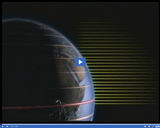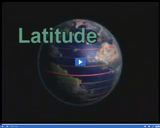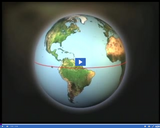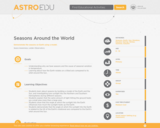
Areas near the equator receive the sun's rays more directly throughout the year, resulting in an overall warmer climate.
- Subject:
- Science
- Provider:
- Utah Education Network
- Author:
- Visual Learning Company
- Date Added:
- 02/28/2010

Areas near the equator receive the sun's rays more directly throughout the year, resulting in an overall warmer climate.

Latitude is the measure of distance north or south of the equator. The equator has a latitude of 0 degrees, and the north and south poles have latitudes of 90 degrees.

Lines of latitude run parallel to the equator, which is at zero degrees latitude. The north pole is 90 degrees north latitude and the south pole is 90 degrees south latitude.
Students will learn about latitude, longitude, and how to read a grid.

Description:
Build a model of the Earth, with its spin-axis, and a lamp as the Sun to demonstrate the concept of seasons.
Goals
--Understanding why we have seasons and the cause of seasonal variation in temperature.
--Learning about how the Earth rotates on a tilted axis compared to its orbit around the Sun.
Learning Objectives
--Students learn about seasons by building a model of the Earth and the Sun, and investigating how sunlight hits the Northern and Southern Hemispheres during different seasons.
--Students explain that the same amount of light hitting the ground heats up a small area more than a large area
--Students show that the angle at which the sunlight hits the Earth influences how much the sunlight heats up the Earth.
Students demonstrate that the angle at which the sunlight hits the Earth is related to the tilt of the Earth’s rotational axis compared to the Earth’s orbit around the Sun.

This free, standards-based website developed for elementary teachers provides hand-picked, reviewed, on-line resources to enhance teacher content knowledge regarding reasons for the seasons.